Table of contents
Fennel seeds ( Foeniculum vulgare ) are used as a dried spice ( raw ) or as an ingredient in tea. The aromatic tea has a calming effect on stomach and intestinal complaints. Organic quality is preferable.
Use in the kitchen
Fennel seeds can be added to a wide variety of dishes and baked goods as a tasty and digestive spice. Due to the essential oils they contain, their taste is reminiscent of anise .
How do you use fennel seeds? Fennel seeds are used dried. They are usually available whole or ground into powder. For the most part, you can assume that local organic products are raw food quality. 25 Shortly before use, you can also roughly grind them using a mortar, which allows the flavor to develop particularly intensely. When seasoning, you should initially be careful and sparing, as the aroma can quickly dominate.
The fennel seeds of all varieties are used as a spice in the kitchen, but sweet fennel is the most commonly used; bitter fennel (also called wild fennel 24 ) is used somewhat less frequently. The seeds of bulb fennel can also be eaten. However, the sprouts are mostly used as a vegetable. 27
Depending on the geographical origin, genetic makeup and degree of ripeness, there are differences in the chemical composition of essential fennel seed oil. Sweet fennel seeds contain little fenchone. 26 The higher anethole content adds a slight sweetness to the aniseed taste. This makes sweet fennel feel mildly sweet, making it particularly suitable for children. It combines well with caraway , cinnamon , coriander ,pepper and aniseed . Raw bitter fennel can be recognized by its woody, spicy and camphor-like accents, which are characterized by the pinenes and the larger proportion of fenchone. 26 It therefore goes well with cinnamon and pepper as well as cumin.
To intensify the taste, you can also roast the seeds - but this will result in a loss of the healthy ingredients. We therefore advise against this.
Fennel seeds are particularly popular in Indian cuisine. They are a component of spice mixtures such as curry powder and garam masala , but also in Chinese five-spice powder. They can be used to season stews and soups. Fennel seeds are popular in fish and meat dishes as well as in vegan dishes. They are ideal for hearty recipes with rice , potatoes or vegan "meatloaf". Fennel seeds also go well with cauliflower, tomatoes or peppers ; they can also be used to enrich leeks, cabbage or carrots. The seeds can also be found in flower salt and grissini as well as sauces and marinades.
Fennel seeds are particularly popular for refining bread and baked goods, such as oriental biscuits or Christmas treats. The seeds are added to the dough and worked into it - or sprinkled on top. The fennel seeds can also be pickled to make flavored oil or vinegar (e.g. for salad dressings).
When taken as a tea, the seeds of sweet or bitter fennel have a calming and carminative effect on stomach and intestinal complaints. Since anethole in particular is considered to be an antispasmodic 24 , the effect of sweet fennel, which is richer in anethole 26, can be stronger. Alternatively, you can chew some raw fennel seeds in your mouth to quickly get to the valuable fennel oil. This simple method brings rapid relief from complaints such as flatulence, bad breath and a feeling of fullness.
Vegan recipe for cauliflower and lentil soup with fennel seeds
Ingredients: 1 whole cauliflower , 150 g red lentils (organic), 2 tsp fennel seeds (raw, organic), 1 liter vegetable stock without added salt , 1 half organic lemon , 1 tsp turmeric (ground), 1 tsp salt , 1 pinchof pepper , 1 tsp rapeseed oil , optional as a topping: 2 tbsppumpkin seeds .
Preparation: First, fry the washed, chopped cauliflower in 1 teaspoon of rapeseed oil until lightly browned. Add the fennel seeds and turmeric and fry for a minute. Then stir in the lentils and vegetable stock, bring to the boil and then reduce the heat. For a healthier version, you can skip frying and stir the prepared cauliflower, fennel seeds and turmeric into the stock with the lentils.
Simmer with the lid closed for 25 minutes until the lentils are soft. Now puree the soup with a hand blender until the consistency is creamy, then add lemon juice and ground black pepper. Finally, season the vegan cauliflower and lentil soup with salt. When serving, you can sprinkle the soup with pumpkin seeds.
Recipe for fresh fennel seed tea
To make fennel seed tea, you can use whole or crushed seeds. If you don't have a mortar, you can crush the seeds with a suitable object. To make the tea, take 1-2 teaspoons of fennel seeds and put them in a tea strainer or tea filter in a cup. Then pour 250 ml (¼ l) of boiling water over them and let the fennel tea steep for 10 minutes. Then remove the tea strainer and enjoy the tea.
Vegan recipes with raw fennel seeds can be found under the note: " Recipes that have the most of this ingredient ".
| Not only vegans or vegetarians should read this: Vegans often eat unhealthily. Avoidable nutritional mistakes . |
Purchasing - Storage
Where can I get fennel seeds? You can buy fennel seeds (mostly sweet fennel) in the spice section of supermarket chains such as Coop , Migros , Denner , Volg , Spar , Rewe , Billa and Edeka and in organic supermarkets such as Denn's Biomarkt and Alnatura . At discounters such as Aldi , Lidl or Hofer , fennel seeds are not part of the permanent range. You can also buy fennel seeds or fennel powder in specialist tea and spice shops, in health food stores, in drugstores, online or occasionally at markets: bitter fennel seeds are also available there. Organic quality is common.
Fennel seeds form in the flowers of the fennel and look similar to the smaller anise seeds , but depending on when they are harvested, they are predominantly greenish-grey in colour. The harvest takes place in Central Europe in autumn from September to October. Dried fennel seeds are in season all year round . To get the most out of the flavour, you should buy them whole and grind them yourself.
The availability of raw fennel seeds varies depending on the size of the store, catchment area, etc. Our recorded food prices for the DA-CH countries can be found above under the ingredient image - and by clicking on them you can see their development at different suppliers.
Found in the wild
Fennel plants grow wild primarily in the Mediterranean region, where they are native. They thrive there in dry places such as rocky slopes, old walls and roadsides. 1,16,20,24 In Central Europe, the species Foeniculum vulgare occasionally becomes wild, 24 as both bitter fennel ( Foeniculum vulgare var. vulgare ) and sweet fennel ( Foeniculum vulgare var. dulce ) are deliberately cultivated (as medicinal plants and spices). Bulb fennel can also "escape" from gardens and fields and become wild.
Possible confusion with poisonous umbelliferous plants can pose a danger (see below under dangers of confusion).
Storage tips
Fennel seeds are best stored in a dry, cool and dark place. For optimal storage, they should be kept whole and in tightly sealed containers (e.g. made of glass), so they will last for several months. 2
Ingredients - Nutritional values - Calories
Here we realistically show you the ingredients of spices and herbs per 1 g (instead of per 100 g as usual).
1 g of fennel seeds contains hardly any fat or protein, but 0.52 g of carbohydrates (of which 0.4 g are fiber). The seeds provide 3.45 kcal of energy per 1 g. 3
Manganese , calcium and iron are the most important essential nutrients that raw fennel seeds offer. However, because the amount consumed is so small, they and the macronutrients do not contribute significantly to meeting the daily requirement. Far more important for the health value are the secondary plant substances in this ingredient, which can have an effect even in trace amounts. Although all herbs and spices have many health-promoting ingredients, we deliberately avoid the insubstantial buzzword "superfood" here.
Health effects
Are fennel seeds healthy? Fennel seeds contain a variety of active ingredients that offer different health benefits. According to a 2023 review study, the most frequently cited effects of fennel include antimicrobial, antiviral, antioxidant, antifungal, anti-inflammatory and antitumor activities. There are also positive effects on the respiratory and digestive tracts. 5
Fennel seeds are particularly popular for supporting the treatment of respiratory diseases, such as coughs, colds or sore throats. Their anti-inflammatory effect also helps with bronchitis. 7 Fennel seeds can be soothing in tea due to their antibacterial and expectorant effect.
Fennel seeds are also used to treat infant colic. The intensity of the colic is reduced by using a fennel seed oil emulsion. The seeds relieve intestinal cramps and increase the mobility of the small intestine. 11 This is why they are often used for stomach problems, flatulence, digestive problems and abdominal pain.
Publications attribute memory-enhancing and stress-reducing effects to fennel seeds. 5
Secondary plant substances
Many of the health effects of fennel seeds can be attributed to the secondary plant substances they contain. Our article on secondary plant substances provides an overview of the classification of the substance groups, their occurrence in foods and possible effects on humans.
Fennel seeds contain the following secondary plant substances: 30,31,32,33
- Isoprenoids: monoterpenes (fenchone, limonene, α-pinene)
- Polyphenols: phenylpropanoids (trans-anethole, estragole, coumarins), various flavonoid aglycones, flavonoid mono- and diglycosides, hydroxycinnamic acid and quinic acid derivatives, lignans, tannins
It should be noted that the composition of the secondary plant substances in fennel seeds can vary depending on the origin, variety, time of harvest, cultivation and storage conditions and manufacturing process. Therefore, quantities are only of limited use and should only be understood roughly.
The pharmacological properties of fennel seeds are based on the high content of valuable bioactive secondary plant substances of monoterpenes and polyphenols. Depending on the variety, the main components include trans-anethole (60-80%), fenchone (1-10%), estragole (approx. 5%), limonene (1-5%) and α-pinene (0.5-5%). 30,32 According to literature, sweet fennel, with an anethole content of 80-95% (of the essential oil), has 20% more trans-anethole than bitter fennel, which makes it taste sweeter and less licorice-like. The bitter aroma of bitter fennel comes from its fenchone content, which is around 5-15%. Sweet fennel, on the other hand, has less than 1% fenchone. Bitter fennel also has significantly more estragole (15.51%) than sweet fennel (2.87%). 26 The two varieties also show characteristic differences in their α-pinene and limonene content. The composition of the essential oils varies greatly depending on the isolation method and sample, but research tends to agree on the differences mentioned above. 10,15,30
Anethole in the essential oil in particular is known for its anti-inflammatory properties. The anti-inflammatory effect is reflected, among other things, in the significant increase in high-density lipoprotein cholesterol (HDL). It has a positive effect on subacute inflammatory diseases (such as arthritis) and on type IV allergic reactions and has a central analgesic effect. 7 Studies with diabetic rats underline that anethole treatment lowers blood sugar levels, increases insulin levels and improves the enzymes of carbohydrate metabolism in the liver and kidneys. 8 In addition, another study on rats was able to demonstrate that fennel seed extract and its active ingredient anethole are able to protect the liver from diabetes-related damage. The hepatoprotective effect is probably due to hypoglycemic and antioxidant properties. 9
Fennel seeds also reduce sensitivity to pain stimuli. A study with mice showed using a tail-flick test that α-pinene and fenchone in particular reduce pain sensitivity. 10 Bitter fennel seeds are richer in these two substances. 26 Various studies also show the antimicrobial, antifungal, antiviral, chemopreventive and liver-protective effects of fennel seeds, although there may be a different spectrum of effects in fennel oils and fennel seed extracts and therefore requires more in-depth studies. 31,32
Fennel seed oil provides relief for severe menstrual cramps. Clinical studies show that fennel seeds are effective as a remedy for menstrual pain due to their anti-inflammatory and antispasmodic properties. 5 Women suffering from polycystic ovary syndrome (PCOS) also benefit from the properties of fennel seeds. These can have a positive effect on ovarian follicles and on ovulation. 12 Various phytoestrogens in fennel seeds, including phenolic acids, flavonoids, cinnamic acid, coumarins, lignans and tannins, are helpful for premenstrual symptoms, pregnancy and menopausal symptoms. 5,33,34 However, additional studies are needed to better understand the exact mechanisms of action. 33,34
Antioxidants are compounds that protect the body from free radicals. Their effect can help to minimize cell damage and reduce inflammation in the body. 6 The antioxidant properties of fennel are due to the phytochemicals it contains, such as monterpenes and various polyphenols, such as flavonoids and phenolic acids. 5 Depending on the extraction agent used (distilled water, acetone, ethanol), fennel seeds have a total polyphenol content of 6.5-10 mg GAE/g (equivalent gallic acid dry extract). The proportion of flavonoids is approximately 0.04 mg quercetin equivalents per gram. In comparison, the values for flax seeds in this study are: total polyphenol content of 70-84 mg GAE/g; flavonoids of 2.1-5.1 mg QE/g. 4
Fennel seeds contain many valuable bioactive substances which, in addition to their everyday use as a spice, also relieve various respiratory and gastrointestinal complaints, as well as have a preventive effect on diseases such as diabetes, cancer, cardiovascular and inflammatory diseases. 30
Dangers - Intolerances - Side effects
The estragole contained in it is always the cause of debate in connection with cancer. The carcinogenicity of this compound in humans has not yet been confirmed. In addition, the amounts consumed are so small that there are no concerns. The Committee on Herbal Medicinal Products ( HMPC ) stated that the doses required for a carcinogenic effect are very high and that regular use of herbal therapeutic products does not pose a significant cancer risk to humans. 5,13
However, pregnant and breastfeeding women and small children are advised to limit their exposure to estragole. 13 Phytopharmaceuticals containing fennel may only contain fennel fruits with a maximum estragole content of 5%. 29 The estragole content in tea infusions made from whole fennel seeds is lower than in crushed seeds or very finely chopped plant material. The amount of estragole increases if the tea bag is squeezed at the end of the brewing time. 13
Some people have an allergic reaction to fennel seeds, which can lead to skin rashes, itching or breathing problems. Caution is particularly important if you have known allergies to celery, carrots or mugwort. 14
Danger of confusion
In nature, the seeds of bitter or sweet fennel can be confused with the poisonous fruits of the spotted hemlock ( Conium maculatum ). An important distinguishing feature from other poisonous umbelliferous plants (most of which have white flowers) are the yellow flowers of the fennel plant. 20,24,28 We still urge caution.
Use as a recognized medicinal plant
The HMPC classifies both the seeds of bitter fennel (Foeniculi amari fructus) and sweet fennel (Foeniculi dulcis fructus) as traditional herbal medicines. Both varieties are used medicinally for the symptomatic treatment of mild, spasmodic gastrointestinal complaints, including flatulence and bloating and cramps in the context of menstruation. Fennel seeds are also used as an expectorant for cold symptoms such as coughs. 16,20
The daily dose for internal use is 4.5 g (3 doses of 1.5 g each) for adults and 3 g (3 doses of 1 g each) for children between 4 and 12 years of age. Use in children under 4 years of age is not recommended. 16
The healing properties of fennel seeds can be used both internally and externally. For external use, fennel seed oil is used and applied directly to the skin for pain and cramps in the abdominal area.
Ecological footprint - animal welfare
The ecological footprint of a food depends on various factors. The type of agricultural production (conventional vs. organic), seasonal, regional or domestic production or import by truck, ship or plane, different types of packaging and whether the goods are fresh or frozen play a decisive role. 17 Despite extensive research, we have not found any significant figures on the CO 2 footprint of fennel seeds.
The production of fennel seeds is difficult due to the high water consumption only moderately sustainable. 1 kg of fennel seeds requires 8280 litres of water. This water consumption is comparable to that of coriander seeds and anise . The water footprint of spices in general is around 7000 l/kg. In comparison, vegetables have 300 l/kg and grains 1600 l/kg. 18
Apart from that, no significant damage to air, water, land, soil, forests, etc. is known as long as no pesticides are used.
For detailed explanations of various sustainability indicators (such as ecological footprint, CO2 footprint, water footprint), see our article: What does the ecological footprint mean? .
There are initiatives and labels for spices, such as SSI ( Sustainable Spices Initiative ) or NSSP ( National Sustainable Spice Program ), which promise certain sustainability standards. But Rainforest Alliance and UEBT ( Union for Ethical Biotrade ) also have programs that put the cultivation of herbs and spices on a sustainable track through certain supply chain management and certification systems. In addition to preserving biodiversity in the countries where the spices are grown, workers' rights are also secured. Standards for farms and supply chains should take into account the sustainable aspects of production and trade. However, the extent of implementation varies greatly from organization to organization. 19
Animal protection - species protection
Sweet fennel is particularly suitable for the garden because its flowers attract numerous pollinating insects such as bees and swallowtail butterflies due to their intense smell. 23,28
Worldwide occurrence - cultivation
Fennel originally comes from the Mediterranean region. It is now cultivated and, depending on the variety, is grown as a spice, vegetable and medicinal plant. The main growing areas for bitter fennel include India, Egypt, Pakistan, China, countries in the Mediterranean region, Eastern Europe and Argentina. 20
Cultivation - Harvest
There are three varieties of fennel that are cultivated: sweet fennel ( Foeniculum vulgare var. dulce ), bitter fennel (var. vulgare ) and bulb fennel (var. azoricum ). Cultivation takes place by sowing or planting in spring.
Sweet fennel does not form a tuber, as it sprouts directly. It is a one- to two-year-old cultivated form, 21 which is used to produce fennel seeds. 28
Although bitter fennel forms a very small bulb, the plant mainly produces seeds. It is perennial, grows up to 150 cm tall, and produces new flowers every spring. 28
Bulb fennel is mainly grown as a vegetable plant for its sprouting bulbs. As soon as the plant produces flowers, the sprouting bulb becomes woody, which is why the best time to harvest is before then. You can also wait until the seeds ripen to harvest the fennel seeds instead of the bulb. 27
Sweet and bitter fennel are easy to grow and do not have high soil requirements as long as there is the possibility of deep roots. However, both fennel varieties prefer calcareous and loose soil and the location should not be too alkaline or dry. Optimal growth is achieved in mild winter and humid climate regions. 21,29
What do you have to consider when growing sweet fennel? Because fennel is self-intolerant, cultivation breaks of 6 to 7 years should be taken into account. Fennel is also unsuitable for subsequent crops, as the seeds that fall out are disruptive and the harvest residues rot slowly. Fennel should be sown using direct seeding between the end of March and the beginning of April. 21
Fennel plants are susceptible to seedling and emergence diseases caused by fungi in the soil. Pests include aphids, thrips, moths, snails, nematodes, blind bugs and field mice. 21
Growing your own
Fennel grows well in your own garden and can also be grown on the balcony. A bucket or alternatively a tall pot is suitable for growing sweet fennel. It is important to ensure that the pot is deep enough so that the plant can take root properly. It is best to use nutrient-rich, peat-free and loose soil that has a high water retention capacity and place the plant and pot in a sunny location. This also applies to bitter fennel. Sweet fennel gets along well with peas , cucumbers , leeks , lamb's lettuce or celery , but tomatoes should be avoided as neighbours. 22
Young plants are sensitive, which is why they are often grown on the windowsill. This also protects them from snails. Alternatively, the seeds can be sown outdoors from mid-May. Fennel should not be planted directly after umbelliferous plants such as dill , carrots , caraway or parsnips . It is important to consider a changing crop rotation. 22 Fennel has a strong herbaceous structure; when growing all fennel varieties, ensure that there is sufficient space between the individual plants and that there is enough water 29 .
Further information
The botanical name for the fennel plant is Foeniculum vulgare Mill. It belongs to the family of the Umbelliferae (Apiaceae) and is closely related to anise ( Pimpinella anisum ), caraway ( Carum carvi ) and dill ( Anethum graveolens ). 28
Are fennel seeds and fennel the same thing? To simplify things, all parts are called fennel. Strictly speaking, the fruits of the fennel are called fennel seeds and should be distinguished from the above-ground plant and the fennel bulb.
What is the difference between fennel seeds and bulb fennel? Fennel is divided into three varieties that are clearly distinguishable from one another. There is bulb fennel ( Foeniculum vulgare Mill. var. azoricum ), where the bulb is mainly used. With sweet fennel (spice fennel) and bitter fennel (wild fennel), the seeds and flowers are mainly used. 23,24 Wild fennel ( Foeniculum vulgare var. vulgare ) tastes bitter, while sweet fennel ( Foeniculum vulgare var. dulce ) is sweeter and milder.
Alternative names
The synonyms for the sweet fennel variety are spice fennel and Roman fennel. Bitter fennel is also known as wild fennel. Fennel seeds are also called fennel seed or fennel fruit. In the literature, wild fennel also appears as F. vulgare var. piperitum 25 (or F. vulgare var. piperitum 25). ssp. piperita ) and is nicknamed pepper or donkey fennel.
In English, fennel seeds are commonly known as fennel seeds or fennel fruits.
Other uses
In addition to using fennel seeds as a spice and medicinal plant, the essential oil they contain is also used in the production of perfumes and liqueurs. 7 Fennel seeds are also suitable for prevention and as a home remedy for bad breath.

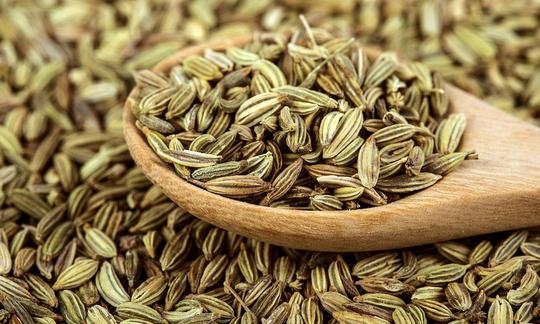

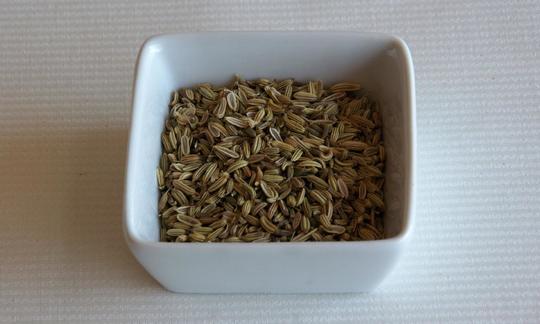

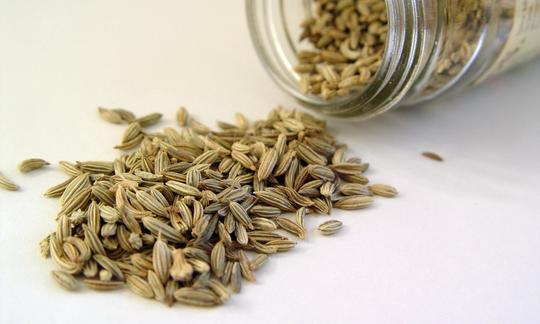

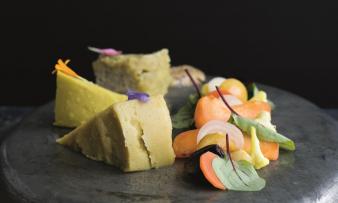

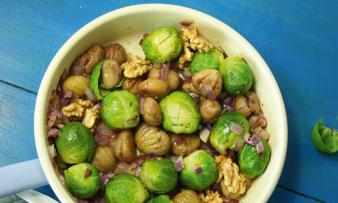





Comments